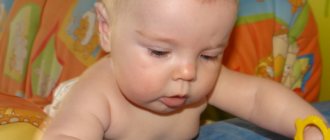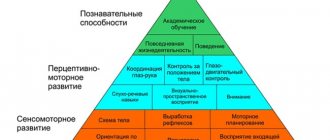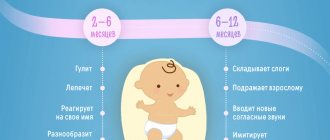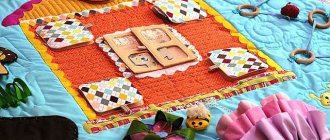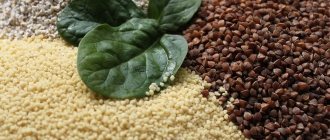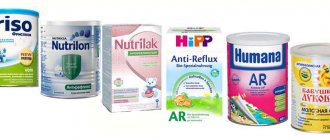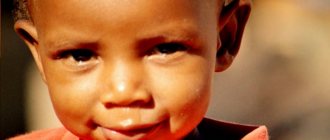A person is born perfect, since nature took care in advance and put into our body everything that is needed in life. But this generous gift must be developed, trained and polished. Do a little experiment and watch your baby. What reflexes does he have? That's right, grasping ones. Even a newborn baby grabs onto her mother’s finger and doesn’t let go. Some say that this is an instinct that prompts one to seek protection, others consider it a random reflex. However, both are right! And if you are wondering how to physically develop a child up to one year old, then start with the development of motor skills.
Fine motor skills in games
For games, of course, you can use any little thing: figures from Kinder Surprises, small construction sets - whatever you like. For example, our favorite toy was a set of tiny children's dishes - very small cups and saucers. The task was to first remove these miniature dishes from the box with your fingers, then set the small toy table: put the saucers, cups on top of the saucers, and do everything so that the table does not lose balance and fall over - I admit, this task is difficult Even I could cope. My daughter did better.
The next item that could captivate Olechka seriously and for a long time were buttons. On this occasion, a large box with large, small, metal, plastic, wooden - bright, multi-colored buttons was removed from the mezzanine. This box became Olya’s treasure, which she played with, of course, only in company with me.
At first, my daughter just liked to put her fingers into the box and sort through the contents. Then transfer and pour into cups. Later, when Olya got a little bored with the routine of sorting and arranging buttons, we began to include this “small-motor” object in our role-playing games. For example, we cooked porridge for dolls and animals - we poured buttons into a saucepan, stirred them, then laid them out on plates. Or they transported “valuable cargo” by putting buttons in a truck and moving from the bear’s house to the bunny’s hut.
Next, we began, choosing the largest and most beautiful buttons, to lay out patterns on the carpet: paths, flowers, and so on. They made “turrets” out of large buttons, laying them one on top of the other.
At an older age, closer to two years, they mixed buttons and beans in a box, and Olya, like Cinderella, had to select the cereal.
Speaking about “fine-motor” games, it is difficult to ignore traditional educational toys. Lacing is considered very useful for the development of small fingers, but my daughter turned out to be indifferent to all types of them. But she was very fascinated by the insert frames (which we not only assembled, but also outlined and painted), puzzles (although Olya, of course, could not yet assemble the whole picture, but connecting the “pieces”, at my prompting, she really liked and served good finger exercise) and “gluing” pictures cut in half.
As Olechka approached the age of two, she really fell in love with books with stickers. The assortment of these books is quite diverse (animals, plants, numbers, letters, etc.), but I noticed that the little one gets great pleasure from the very process of peeling and sticking pictures. Therefore, we began to buy ordinary stickers at stationery kiosks (preferably themed ones - for example, with images of vegetables, fruits, flowers) and stick them in a special album. However, we also continue to use sticker books.
Nutritional Features
Porridge. Porridge for a 9-month-old child can be either dairy or dairy-free.
Among the cereals used are millet, oats, and mung bean. Lentils, peas, semolina and corn are not recommended.
A child can eat up to 200 g of porridge per day (excluding milk).
Vegetables. The diet of a nine-month-old baby includes cabbage, carrots, onions, zucchini, pumpkin, and sweet potatoes. Nightshades (tomatoes, eggplants, potatoes) are not recommended. Vegetables are pureed. The maximum daily amount is 180 g.
Meat. Among meat products, preference is given to turkey, chicken breast, and pork. The meat should be boiled or steamed, minced twice through a meat grinder. A child can consume no more than 50 g of meat puree per day during the main meal (not for breakfast or dinner).
Fruits, berries and juices from them. Among fruits and berries, bananas, apples (not red), pears, and plums can be included in the diet of a nine-month-old baby. Red fruits and berries, citruses and sea buckthorn should not be eaten. Fruit puree is prepared, the maximum amount of which per day is 70 g, or juice, which can be consumed up to 50 ml per day (only in diluted form).
Dairy products. The diet includes butter (no more than 5 g per day), cottage cheese (but not ready-made curd mass) - no more than 30 g, fermented milk products (yogurt, kefir, yogurt, acidophylline) - no more than 150 ml per day. Fermented milk products should be consumed separately from other dishes and should not be eaten in the morning or at night.
Dish recipes
- Apple and carrot puree. Ingredients: 1 apple, half a carrot, 2 tbsp. boiled milk, 2 tsp. Sahara. Preparation: 1) Peel the apple and carrots, remove the core from the apple, grind the apple and carrots in a blender until smooth. 2) Mix the mixture with sugar and pour milk on top. You can crumble some cookies.
- Pumpkin with chicken fillet. Ingredients: 100 g fresh pumpkin, 30 g chicken fillet, 3 g butter. Preparation: 1) Wash the pumpkin and meat, cut into small cubes, mix. 2) Simmer the resulting mixture over low heat with the addition of butter until the chicken is cooked (20 minutes). 3) Bring the mixture in a blender until smooth, add a pinch of salt. Serve warm.
Fine motor skills and creativity
As you know, modeling and drawing in themselves are powerful tools for developing fine motor skills. I will draw attention to some points that were well used at this particular age.
- drawing with a piece of foam rubber. There are two points here - firstly, the child likes tearing small pieces from the foam rubber in itself. Secondly, squeezing these pieces while drawing is a very good exercise for a child's hand.
- painting with a cotton swab or match requires more effort than when painting with a brush
- and, of course, finger painting
As for modeling, then, of course, kneading plasticine, rolling plasticine balls in your hands, tearing off small pieces, gluing them on paper - the list goes on for a long time. Together with my daughter, we made (and continue to do) crafts from plasticine and various materials. For example, a plasticine doll. I roll a ball (it turns out to be a head), and Olya is asked to tear off two small pieces of plasticine and attach eyes to the doll. Then roll a plasticine sausage (she knows how to do this), which together we turn into a mouth. And finally, attach “hair” to the doll. We use pasta in the shape of spirals as “hair” - and funny curls appear on the doll’s head. The construction of such a “wig” is within the power of Ole herself.
There are simpler crafts that a child can do on his own. For example, “hedgehog” - the baby is asked to stick a piece of plasticine with matches. Or a “New Year tree” - decorate an ordinary fir cone with plasticine pieces. Well, and so on.
To my surprise, another tool for developing motor skills, akin to plasticine, turned out to be... foil. Yes, yes, an ordinary sheet of food foil can be twisted into a flagellum and from this flagellum you can build something.... for example, a ring, a horseshoe, etc. You can try rolling small pieces of foil into balls. And the simplest thing, what Olya really liked, was wrapping and unwrapping small objects, for example, figures sculpted from plasticine through our joint efforts with my daughter. In the same way, we wrapped pasta figures in foil.
By the way, curly pasta (in the shape of shells, flowers, leaves) is our special love. You can do anything with them. You can simply stick a piece of plasticine with pasta flowers or shells and make a “flower meadow” or “seashore”. You can try stringing the same pasta on a fishing line and making a cute necklace or bracelet. Or you can simply lay out improvised patterns on a sheet of colored paper - it turns out very interesting and beautiful.
Colored paper is also a useful item. The baby is not yet able to use scissors (there are attempts, but so far to no avail), but tearing a sheet of colored paper into strips is a real pleasure. Colored paper tears more easily than, for example, old newspapers, and, of course, a child is more attracted to bright colors than an unassuming sheet of newspaper.
Well, this is probably the main thing, our favorite.
Indicator of neuropsychic development
Baby development test at 9 months
- Take two spoons (or other paired objects) and show the child how to hit them. If you then give objects to the child, he will begin to imitate the actions of an adult.
- If you try to take a favorite toy away from a nine-month-old child, he will begin to actively prevent this - he will hold the toy tightly to himself or will tug at it.
What should you be wary of?
Important! The following signs may be alarming in the behavior of a nine-month-old child, and if present, he should be shown to a doctor:
- The child does not repeat syllables after other people.
- Not afraid of strangers.
- He doesn’t get angry and doesn’t react in any way if you take a toy from him.
- Cannot roll over or maintain a sitting position.
- Doesn't crawl.
- Does not try to drink from a cup on his own, does not take off his clothes, does not play with other children.
On our website there are also articles about the next months of the baby’s life, such as 10, 11, 12 months.
Fine motor skills in the kitchen
In our kitchen, games with cereals are a traditional hit parade. The activity is exciting, and the child can concentrate on it for quite a long time. Mom is preparing dinner - and the baby is busy.
So, the cereal gets (buckwheat, peas, rice), the child is given small cups from the doll set (it’s convenient to pour them over), spoons, bowls, glasses - all this is placed on a tray, and then the baby plays with the cereal for his own pleasure: rakes it with his hands, sorts out the grains, pours them from one container to another, etc. When I have a break in work, together we lay out patterns from the cereal on a tray. We select a tray that contrasts with the cereal (for example, if it’s rice, we take a dark tray, if it’s buckwheat, then vice versa) and lay out paths, houses, flowers... Or we fill the entire tray with cereal, and the daughter runs her finger along it with concentration, looking with curiosity at the stains that appear .
In addition, to play with cereals, we like to use egg trays or candy boxes with compartments - Olya really likes to distribute the grains into “nests”. In addition, this activity takes quite a lot of time and does not require my participation - all I have to do is gradually monitor compliance with safety precautions.
However, cereals are not the only type of “kitchen activity”. Olya loves to “help”. For example, sorting and washing potatoes in a saucepan. Peel boiled vegetables (potatoes, carrots) or eggs with your hands. Why not a developing exercise for fingers? Olechka even likes to peel onions with her hands - and she doesn’t cry at all.
Ever since my daughter learned to crawl, the lower sections of the kitchen cabinets were cleared for “research equipment.” There I put safe, but interesting for the child items: plastic dishes, small dishes and bowls, and, among other things, plastic bottles with screw caps. These bottles fascinated Olya for a long time: unscrewing and tightening caps and trying them on other bottles is a very interesting and quite labor-intensive activity for a child’s hand.
The only side effect of our developmental activities in the kitchen is “creative” chaos - well, and, alas, there’s no way without it.
Build paths from dominoes
This may seem surprising to some, but a one-year-old child can already play dominoes! Of course, while there is no need to explain detailed rules to the child, tell him what a “bazaar” and “fish” are, he is unlikely to be interested in this. But the domino principle itself, based on the selection of identical pictures, can easily be grasped by a child.
To play, you will need a children's domino with pictures that the baby can understand (for example, we have this, other options are Ozon, My-shop). Explain to your child that you can build paths (or fences, as you prefer) from dominoes. But the paths are not simple: the dominoes in them must be selected so that the pictures on the edges match. Taisiya and I used dominoes to build a large fence, inside of which some animal would definitely live. Tasya could play dominoes on her own for a long time.
Fine motor skills while walking
Here we can go on for a long time: we all know how much a child is fascinated by collecting natural materials - pebbles, chestnuts, acorns, etc. Autumn is a very fertile time in this regard - Olya and I always returned from the park with supplies of freshly picked acorns and chestnuts, which we sorted through at home, They put them in cups and made simple crafts. While walking, Olechka picked rowan berries from the bunches and rolled them in her palms...
And in the summer it’s wonderful to collect shells and pebbles on the banks of a river or sea, throw them into the water or, conversely, try to grab them from the water with your fingers. Even better, together with your mother, build a sand castle on the shore and decorate it with natural materials.
Of course, this article describes a far from complete list of games and activities that can be offered to a child at this age to develop fine motor skills. There can be a great variety of such games, depending on the interests of the child and the imagination of the parents. But perhaps our ideas will be useful for you too.
Use a sponge to pour water from one bowl to another
The game is in many ways similar to the previous one, but still gives the child slightly different sensations. A few tips: firstly, place a bowl of water on the left and an empty bowl on the right , then the child will pour water from left to right, this direction of action is important for placing his hand before writing. Secondly, it should be noted that it is more convenient to play with a sponge that is completely soft (without a hard part); if you were unable to buy a soft sponge, then cut off the hard part with a knife.
